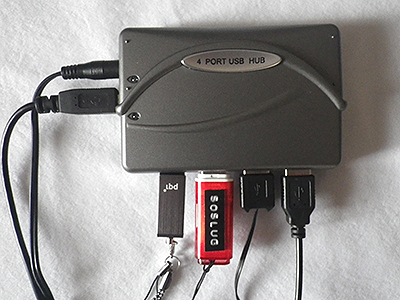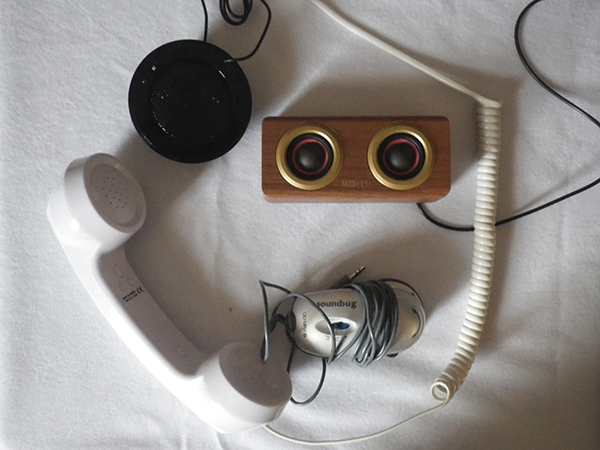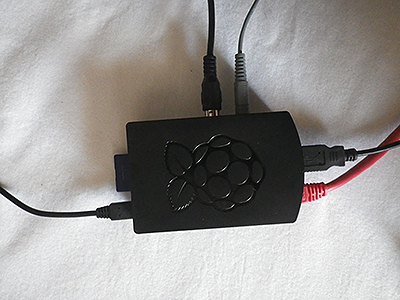|
| |
| |
Cosy Computing |
| |
|
| |
04. Other Connections. |
|
| |
Now for more plugging things in. The Pi is up and running, but so far cannot communicate with other machines, or access any information not already on the SD card.
|
|
|
| |
|
| |
I can connect it to the internet using an ethernet cable.
I can then check my software is up to date using the command line. The command for this is "sudo apt-get update" then "sudo apt-get upgrade" to install any upgrades. "Sudo" means "super user do" and is basically letting the machine know you are its boss. "apt-get" tells the Advanged Packaging Tool (APT) to get something, and then you tell it what it is to go get. Yes that's a bit vague but I'm new at this. I don't want to take commands for granted, I want to understand why the commands are what they are and what specifically they are doing. My understanding of this will begin pretty vague, and grow with more use and context. I won't force that now.
So now I am connected and updated. I can now access the internet through the web browser on the GUI, but there will be a lot more I can do with this later.
|
|
| |
|
| |
I also got the Pi connected using my Dad's old wifi dongle just to see if I could. I bought a powered USB hub as the pi itself only has 2 usb ports. I needed a powered hub as the Pi cannot provide a lot of power to its USB ports. It has a fuse that can blow. While researching this I learned that this was a polyfuse, which is a kind of fuse that self-heals after a while once it blows. But its still not good to blow it as this can take a long time, and the healing isn't perfect. Finding a powed hub for the Pi was a lot of palaver as there is lot of talk about "backpowering" and people wanting to use the hub to power the Pi as well as act as a peripheral. But I don't need that. I got a basic one that had a lot of reviews by people successfully using it with a Pi as a simple powered hub. It only has 4 ports, but that is enough for now.
I also experimented with bluetooth which involved installing other packages, but I couldn't get it to work with my portable bluetooth keyboard. As I don't need bluetooth yet, I havent spent a long time on this so I'll update when I get that to work in the future.
As you can see I've also attached a usb fan there just to see if I could. These are vague early forays into options for visual possibilities for the stall.
|
|
| |
|
| |
Here is the hub with USB sticks in it, allowing me to save to them, and to transfer information to the Pi. |
|
| |
|
| |
I also decided to test out the sound. While the HDMI connection has sound built in, the sound is separate from the RCA composite video. It is the blue port here. It takes this kind of cable. |
|
| |
|
| |
I'm going to connect it with the case closed this time. You can see the ports on the side. And with the sound and video connected. |
|
| |
|
| |
I tested a few different sound options, again just looking for visual or narrative opportunities. Shown are a mobile phone speaker (I like the wood), a pringles can-top speaker, a soundbug (that turns windows and other smooth resonant surfaces into speakers), and a novelty retro handset for a mobile phone. The phone is the most practical for the fete, as loose sound will get lost in the space and interfere with other people's work. It could also be potentially useful aesthetically and as an interaction.
To test the sound, I first tried playing a video on youtube. This did not work. At this point, I don't need to find out why. I put an mp3 on a memory stick and tried to play that. The Pi had no built in mp3 player, so I researched a couple of command line ones that I couldn't get working. I didn't feel like spending much time on this as sound isn't likely to be a big part of the stall, so I downloaded the free XiX player through the Raspberry Pi store. This worked right away.
|
|
| |
|
| |
so with the case closed and everything else connected, the Pi looks like this. I've made a good basic practical start, and from this point can start to specify what I want to do.
I am thinking of setting up the Pi as a simple interface where people can talk with Pinnochion#1. There are lots of ways of doing this. The most simple will be to bring up the Pandorabots web page and interact through that. However I would like to explore other possibilities. The challenge is going to be balancing the time spent learning new skills, making sure it is technically stable, and developing the aesthetic. This element is only one part of the stall and it would be very easy to spend the whole time on just this. Just programming the bot itself is very time heavy. I would like to keep the interface as simple as possible.
There are lots of things I would like to be able to do. If I could find a way to capture the conversation text in real time it would be possible to output it to a printer so people could take a transcript of their conversations away with them. The conversation interface need not take place on a monitor at all, it could be outputted to LED or LCD displays. My instinct is that to learn how to do that for this project is too time-heavy, but I will continue to look into the possibilities of developing this further.
|
|
| |
|
|
| |
| |
| |
|
| |





